Ashok Vajpeyi in conversation with Piyush Daiya
Editor’s Note
Poet and cultural cognoscenti Ashok Vajpeyi is turning 85 this 16th and is documenting his memoirs with writer Piyush Daiya. As part of the memory project, we are publishing his detailed impressions of four women artists. This is the second of the four-part series.
Read the first part (Nilima Sheikh); third part (Nalini Malani); and fourth part (Mithu Sen)!
Arpita Singh’s Art Style
If you look at Arpita Singh’s painting oeuvre, you realise that she makes an effort to address contemporary and concurrent violence. The sense of suffering, (just like Nilima Sheikh) becomes more intense and comes into the address. It’s not very necessary to be a woman to understand the violence depicted in Arpita’s work or the way violence is attempted contextually. It’s not necessarily violence seen through the eyes of a woman. It is the violence of our time, that can be identified. Weapons, guns, knives and such things appear in her paintings. But besides the overt and very clearly visible forms of violence in her work, there is also irony and anguish, which has been addressed. It can be said that the canvas in Arpita Singh’s work is a bit more vocal and contemporary. She is, in a way, seeing her time more intently, there is less memory of any other time in her work, or at least it is not being echoed as much. She is not drawing as much from tradition for her symbolic system as she is from our contemporary landscape. In Bengal, idols of Kali or Durga adorned with weapons are still made across the country today, which have a traditional connection, they are forms of expression. In the context of Arpita ji, there can be two meanings to the resonance, which we spoke about. If there is such a resonance, it will connect the violence in her work with the violence that has happened before. If that resonance is not there, then perhaps the painter is saying that connecting this violence to another violence, or violence from before, will not reduce the inhumanity, cruelty, or damage caused by this violence; therefore, such resonance with tradition is unnecessary. It can also be thought of this way.
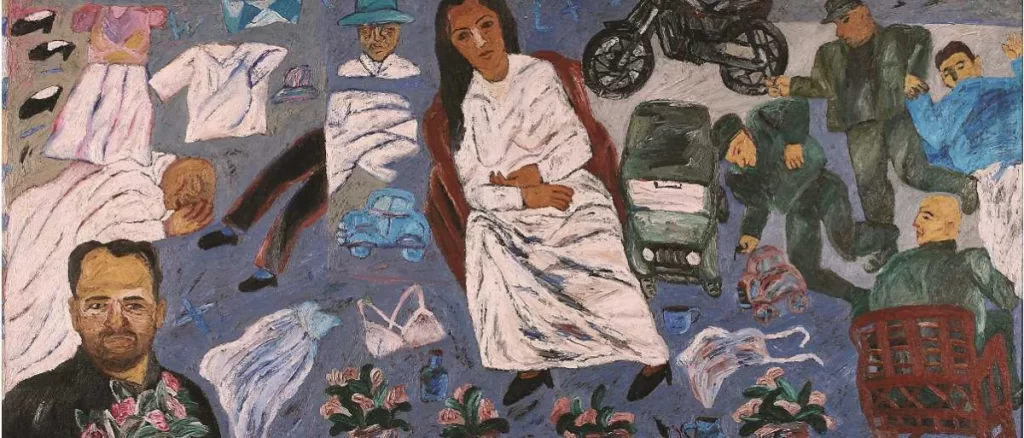
Insistence on the Contemporary
Modern women artists have not been restricted by hesitation and taboos; they have not surrendered to them in any way. Rather, they have also tried to demolish those taboos and those hesitations. Nalini Malani, at another level, by making her medium state-of-the-art and by almost demolishing ethnic memories, has created a contemporary that doesn’t evoke any ethnic memory. A kind of contemporaneity also emerges in Mithu Sen’s work. This has its justification. Because sometimes it feels like this has always been the case. This feeling can awaken within. These women (artists) are aware of that. ‘This has always been the case’ should mean that this should not happen anymore. The violence, suffering, humiliation, marginalization, etc. happening today is more cruel and more destructive. It is happening in a civilization that has gathered all the tools to make itself more independent, more free, more egalitarian, more just, and more healthy. In such a case, it is more inexcusable to happen than in the time when all these tools were not so widespread and so capable. This is a way I see to understand the insistence on the contemporary.
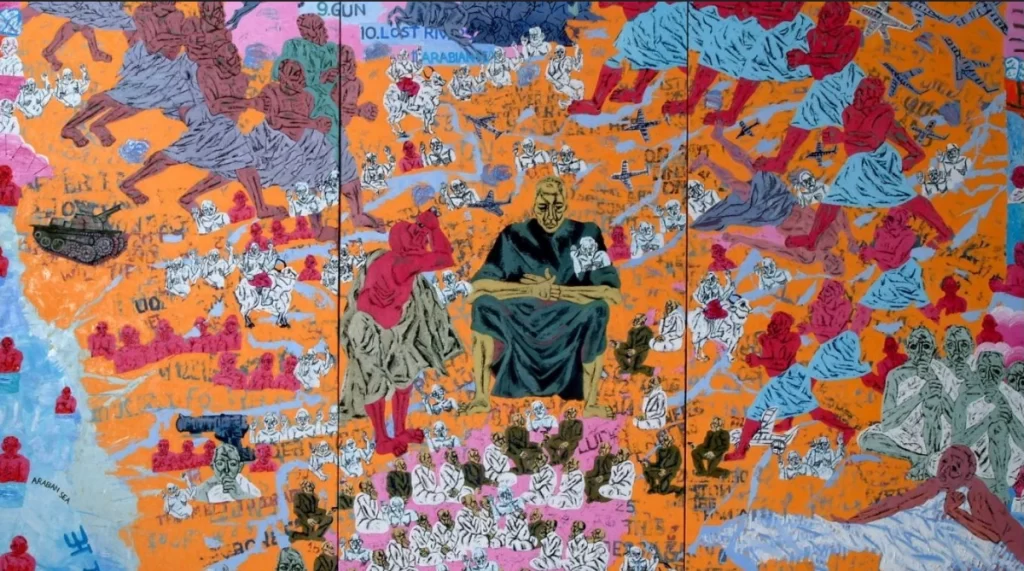
Courtesy – Architectural Digest India
From Behind the Curtain
In the art of women painters, even in their relatively more aggressive paintings, they leave a gentle elegance. It does not go out of the canvas or the artwork. It takes some form in it. Often, it takes such a form that it feels like a kind of satire. For instance, in Arpita Singh’s work, if there are guns, there are also flowers. I understand that this strategy can only be used or has only been used by women. Perhaps, it can be done elsewhere too.
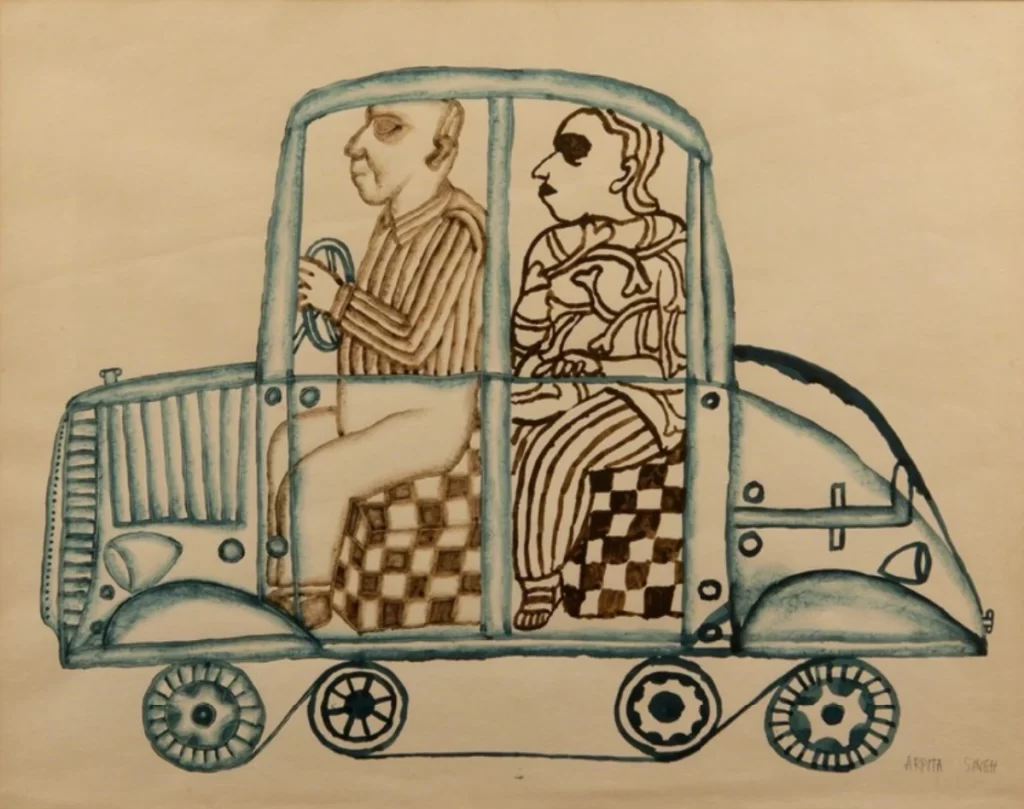
Courtesy – Artsy
There is a robust, assertive presence of the picture in Arpita Singh’s work. In Nilima Ji’s work, the colours are a little slow; a little greyish. In Nilima Ji’s work, it may seem that a woman is watching from behind the curtain – what looks faded and hazy is the view seen from behind the curtain. Here, to me, the taboo itself will become a metaphor.
Harmony
In a way, there are two traditions of Bengal. One tradition is where there is an insistence on elegance, beauty, life, diversity, the multiplicity of life, etc. There are many people in this tradition, including Nandalal Bose and more. The second tradition addresses the gap, wounds, and divisions of our time, such as the paintings of Chittoprasad or Somnath Hore. It is difficult to say what Arpita has taken from these two traditions, but her work aligns with the second tradition. No tradition is entirely separate from its concurrent second tradition. Traditions are part of a flow and many elements of that flow are the same in several currents. Therefore, the aspect of elegance, the vision of beauty, or the multiplicity of life, is not unnoticed in her work either. But her main focus is on the other side.
There is a harmony between Arpita Singh’s painterly mind and her painting canvas. Harmony in the sense that whatever she thinks, reads, writes, sees, all of that together creates her mind, and she marks that mind, if not verbatim, then almost completely. Her painting—her depiction—is full of many kinds of complexities. These complexities seem straightforward, but they have some curvature: it is often difficult to see or capture that curvature, but without it, the full meaning of her paintings cannot be made autonomous. Take her painting in which violence is depicted. Despite the violence in the painting, there is also an expression of the humanity that is left or unaffected by it, or is untouched by it: it would be incomplete to only observe the violence and not see the untouched.
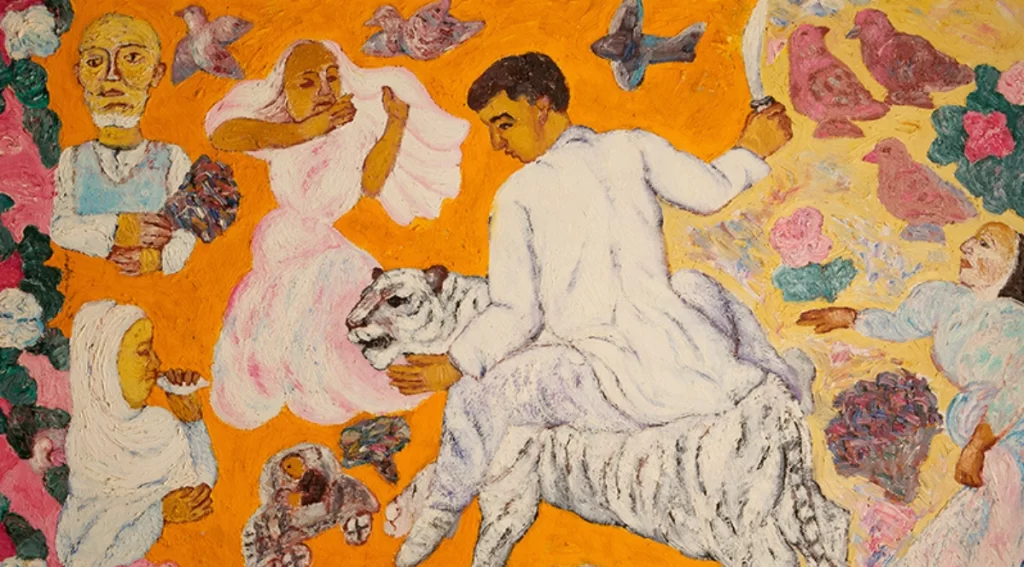
Courtesy – Museum of Art and Photography
Arpita is one of those rare artists who has been constantly exploring new directions. So far, only one major aspect of her painting work — violence, has been taken, but there are other aspects in her work. Going towards those other aspects means that there is a lucid tendency in her to keep choosing something, from wherever she gets it. If she gets it from the Tibetan Buddhist tradition, then that’s fine, if she gets it from somewhere else, then that’s fine: that is why her work is diverse,and multifaceted.
I started getting to know Arpita during the Bhopal days. Mainly from the days of Bharat Bhavan. I have known her more since I came to Delhi. Based on what little I know, I believe Arpita is intrigued by poetry. Arpita can be seen as a person who goes here and there and whatever she likes or is drawn to, she keeps it in her basket as if without thinking or knowing when, where or how it will be used in her art. Everything that every important artist does in their art—whether as a subject, material, skill, or idea—is not necessarily suddenly revealed from somewhere at that time: it often emerges from the basket, which is ultimately a basket of memory. Arpita has certainly done such a collection continuously, so she can also be called a collecting painter.
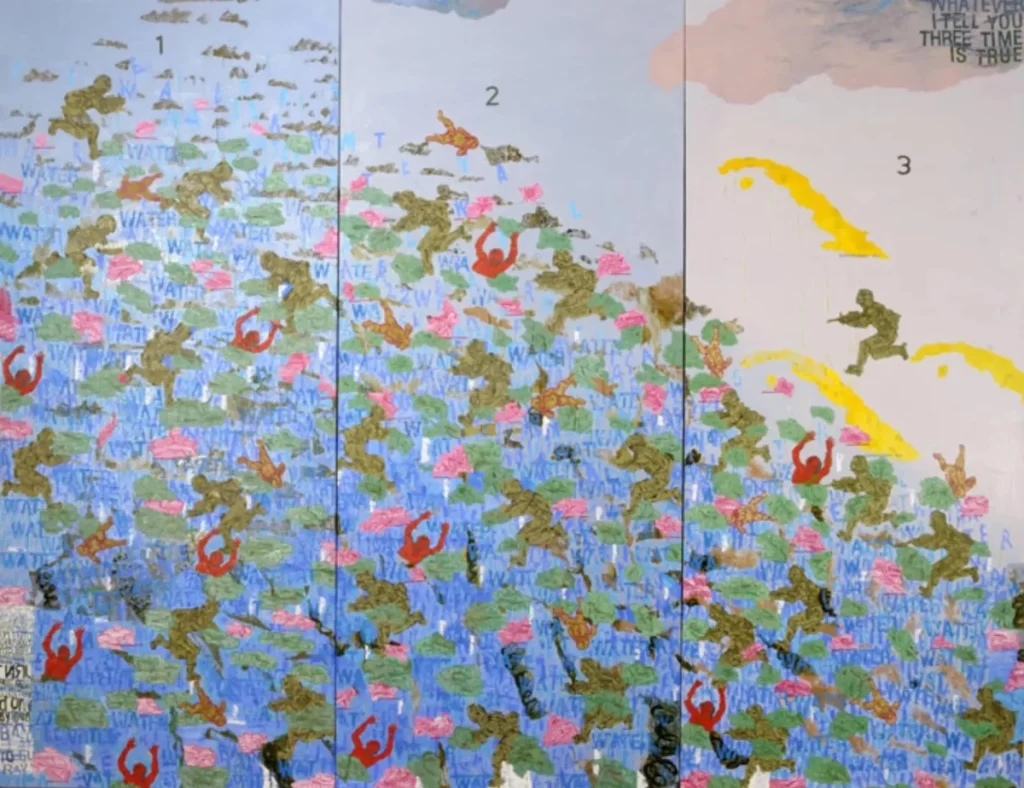
Courtesy – Vadehra Art Gallery
Memory Bank
At one time, most artists started their work with watercolours. Raza and all the others did so. They moved towards oil paint and acrylic later. In a way, watercolour is a primary medium. Working with watercolours is doing primary work. For some artists, this priority remains or returns time and again, like in Swaminathan’s work. At Swaminathan’s almost penultimate exhibition held in Chennai, there were only watercolour paintings. I think the same must have happened with Arpita too.
Perhaps, one difference between watercolours, oil paints and acrylics is that watercolour is more fragile. The fragility of watercolours seems to be fixed. There is a sense of permanence in oil paint and acrylic, durability. One meaning of choosing or using both types of methods can be that the artist concerned considers both fragility and permanence as desirable for art. It may happen that sometimes the thought comes that this life itself is so fragile that what is the need to do something very permanent or timeless in it? On the other hand, it may also seem that something lasting should be done. This is a matter of speculation. I cannot give any basis for this.
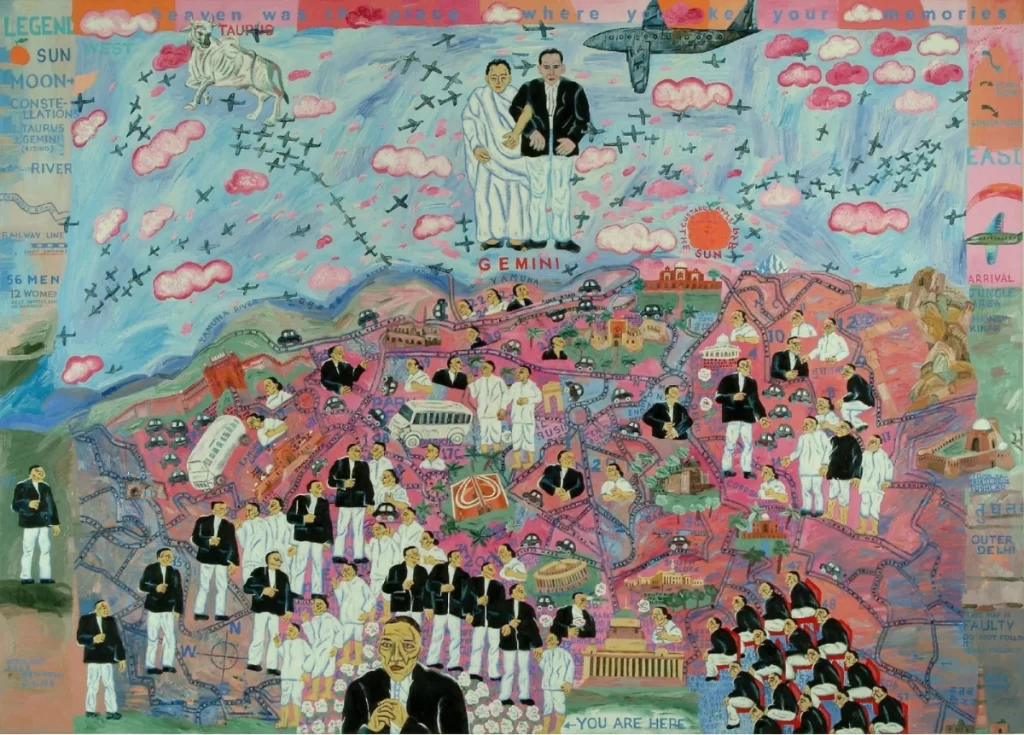
Courtesy – Vadehra Art Gallery
I think that in our primary memory of seeing and doing, both words and numbers play a very important role. We begin to know the world through words and numbers—the whole system comes from these. I think, it is a kind of pre-memory, which becomes lax or disappears in most painters’ work. It is preserved in Arpita’s work. I don’t think she does this to make the pictures more communicative. I think she gives opportunities to her memory bank, to make pictures from that bank.
Hues of Everyday Life
I understand that Arpita always remembers that ultimately art happens only in everyday life. The artwork is made at home, at least she makes it at home, in her studio. And everyday life is scattered all around. In a way, she gives space to art’s inherent human context in the picture; there isn’t any theatricality in them—there is a kind of beauty in domestic simplicity, which she uses.
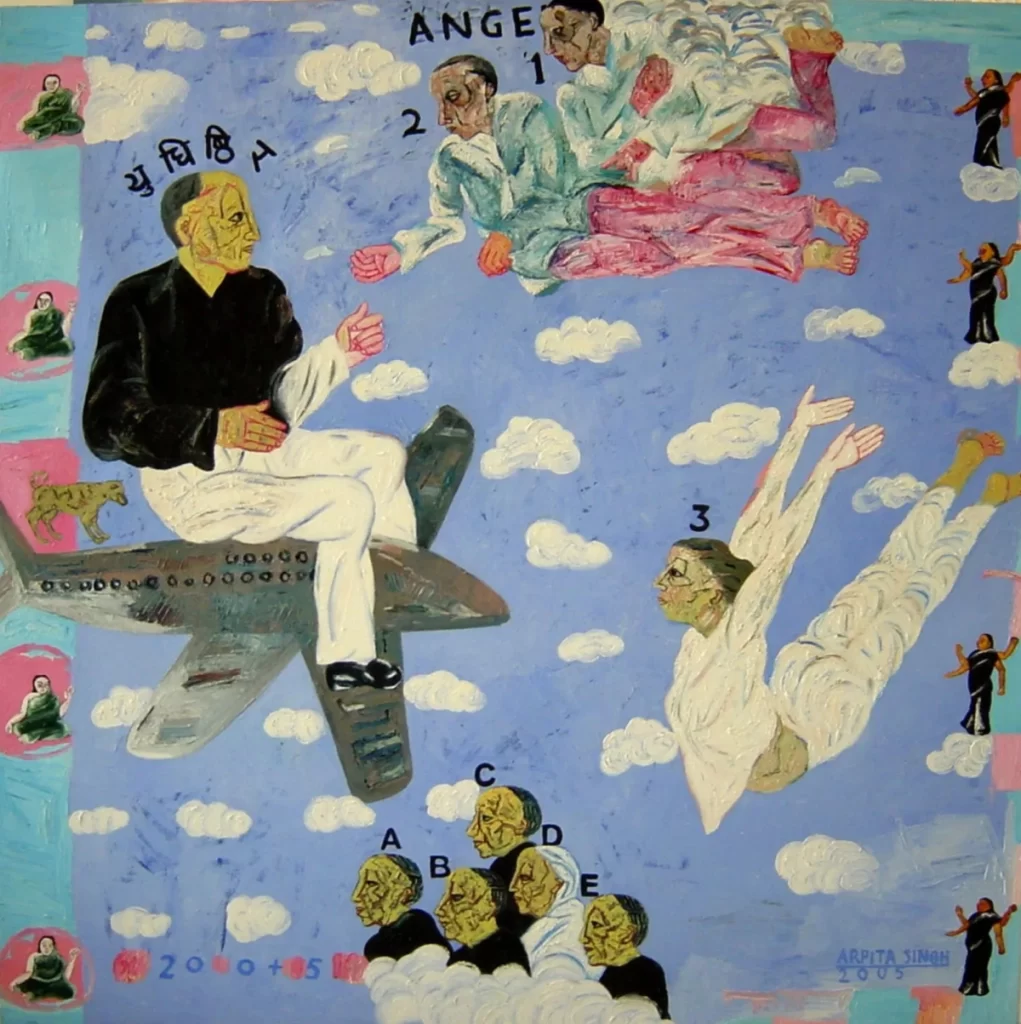
Courtesy – Vadehra Art Gallery
Take Arpita’s color palette. Pink appears a lot in her paintings. Very few artists have used the colour pink, so it has become her right. Every artist falls into the trap of some colours and these colors almost begin to define that artist. These colours do this in Arpita’s work. Another thing is that frequently in our art, such colours do not find prominence which has a lot of space in everyday life, such as pink. The meaning of grasping that colour is like giving an artistic form to a hue of everyday life.
Relationships of Opposites
Often, in Arpita’s work, the subject and the colour combination share an opposing relationship. This is interesting. It is expected, and most painters also do this, that they adapt their colour scheme to their subject, while Arpita, I think, deliberately makes it adverse. There lurks a serious dramatic quality in Arpita’s art, not just a showy one. It is not immediately grasped at first glance from above. We can say that it is the drama of life. Like many times there are dramas in life, but we neither grasp nor see that drama.
There is a tendency in Arpita towards humour, which is rare not just in women artists but also in male artists. It’s like it’s better to laugh at your irony than to cry or whine over it. One is some feeling. Second, somewhere there is also a feeling of teasing in Arpita. Of making a little fun. It is also somewhat present in her behaviour. It probably also comes in her paintings. This laughter, this sense of humour is somewhat similar to the style of ‘this laughter used to say a lot’. If a small job of art is also to teach us how to endure the truth, then it is there in Arpita’s work.
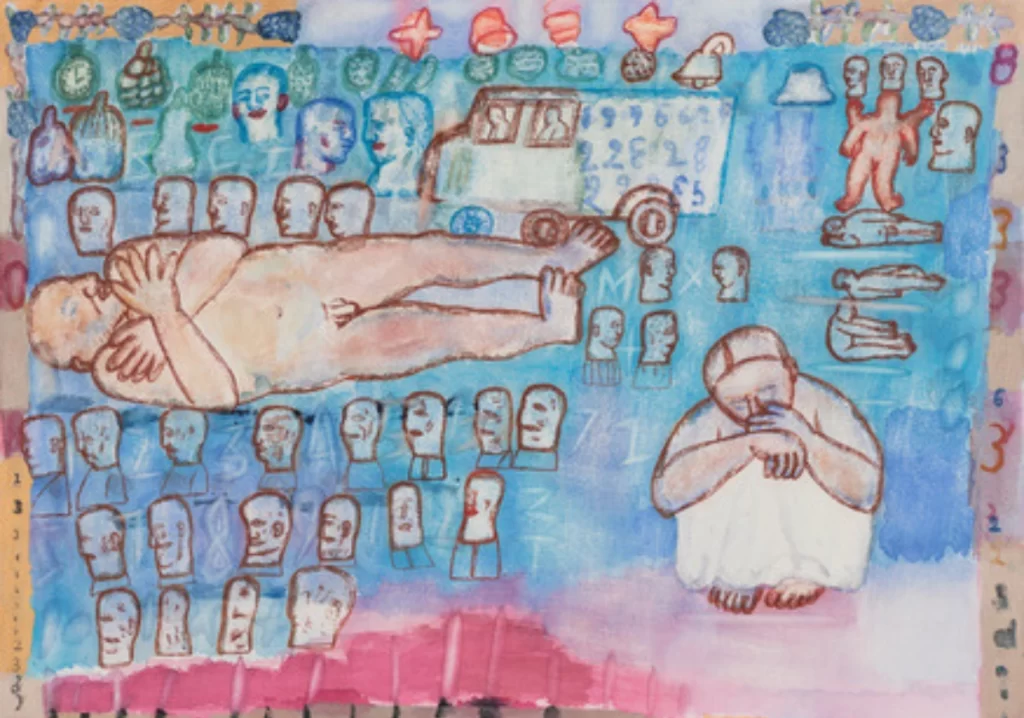
Courtesy – Saffron Art
Possibly this may be a way of revealing the poignancy of the sense of irony that is interwoven with her painterly vision, which I had initially pointed to—in the context of suffering, etc. The beauty is that it appears in such a place where it was not expected or there was no such apprehension that laughter or a smile would appear here. This is its artistic peculiarity.
Image Courtesy – Mahanagar Times
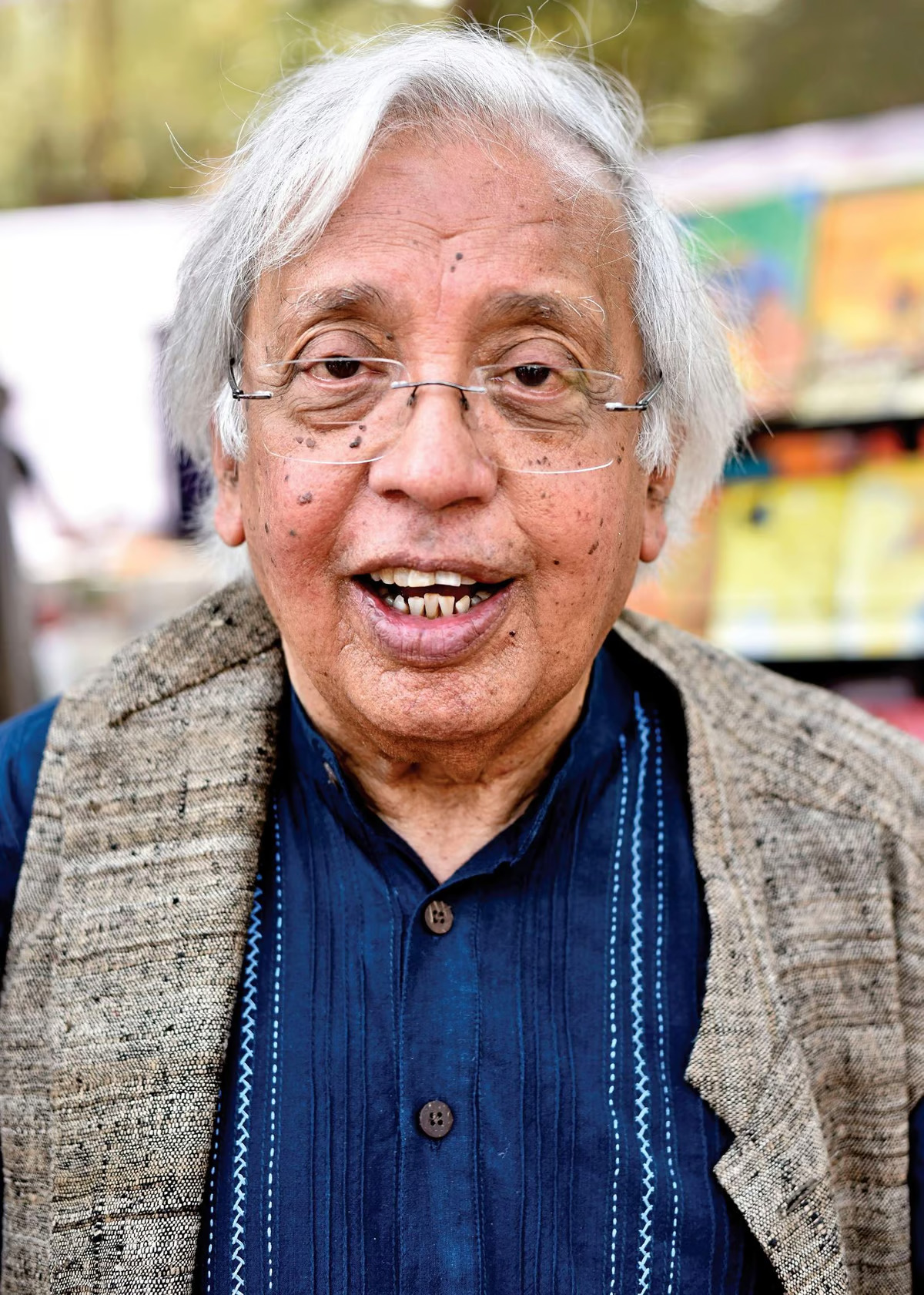
Ashok Vajpeyi is a Hindi poet and critic with fifteen books of Hindi poetry and volumes of criticism on Visual Arts, Literature, and Indian Classical Music to his credit.





